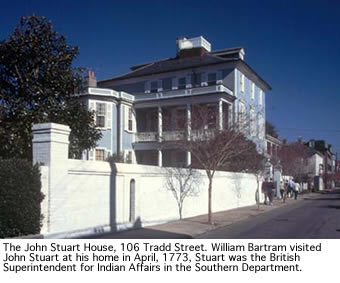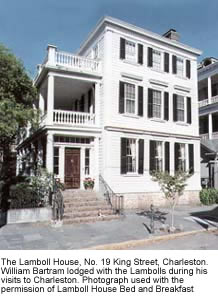-
-
-
-
-
-
-
-
-
South Carolina
-
-
-
-
-
-
-
-
-
-
-
-
-
-
-
-
-
-
-
-
William Bartram began his eventful four year journey  through the Southeast by sailing to Charleston, South Carolina. For four years he used it as a base of operations both because of its strategic location and because of the presence there of many family friends and men of science. Dr. Lionel Chalmers was among the most important of these. The leader of scientific activity in South Carolina, Chalmers acted as Dr. Fothergill’s agent in supervising Bartram’s travels.
through the Southeast by sailing to Charleston, South Carolina. For four years he used it as a base of operations both because of its strategic location and because of the presence there of many family friends and men of science. Dr. Lionel Chalmers was among the most important of these. The leader of scientific activity in South Carolina, Chalmers acted as Dr. Fothergill’s agent in supervising Bartram’s travels.
Bartram’s initial stop in Charleston in April of 1773 was a brief one. After a few days rest there, he embarked by schooner for Savannah, Georgia.
After a summer of travel in Georgia and Florida, Bartram returned to Charleston (by water) in the fall of 1774, “where being arrived I spent the season in short excursions until next spring.”(28) One wonders exactly where these “short excursions” took Bartram during this period. Some of the time must have been spent with Dr. Alexander Garden who Bartram had first met while in the company of his father at Cadwallader Colden’s house in New York State (1754). Dr. Garden’s plantation, “Otranto,” boasted an important botanical garden where the South’s leading naturalist (and correspondent of Linneaus) undoubtedly spent many happy hours with his young friend from Philadelphia. William Bartram stayed at the Thomas and Elizabeth Lamboll House while visiting in Charleston. The house was owned by the Lamboll's daughter, Mary Lamboll Thomas, when Bartram visited in late 1776.
Exploration of Cherokee Country, 1775
Bartram left Charleston in the spring of 1775 (not 1776 as he claims in Travels) to explore the Cherokee Nation to the north and west. He traveled by horseback up the northeast side of the Ashley River and crossed at a ferry near the site of Drayton Hall. From there he traveled southwest to Rantowle’s Creek and Wallace River, where he joined the Charleston Savannah road (roughly followed by Route 17 today). This he took to Jacksonburg or Jacksonboro on the Edisto River.(29)
His route from Jacksonboro to Pocotaligo (Jasper County) probably took him by way of Ashepoo and Gardens Corner on a road he and his father had taken in 1765.
The Three Sister Ferry (better known today as Two Sisters or Sisters) at which he crossed the Savannah River into Georgia is about 15 miles west of Ridgeland, Jasper County.
A short time later, on his way north to Augusta, Bartram crossed into South Carolina at Silver Bluff as he had on several occasions earlier. Bartram described the unusual geological feature (which abounds with fossiliferous material) as “a very celebrated place”(30) and remarked on its rapid erosion by the river. Before crossing back into Georgia, Bartram examined Fort Moore, now inundated, where Mark Catesby had visited some fifty years before.
In his northward travels to explore the Cherokee Country, Bartram crossed back into South Carolina (May 10, 1775) at the site of the former Calhoun Ferry, about seven miles up the Savannah River from Ft. James and the mouth of the Broad River.
From this point, he took the “high road” through Calhoun Falls (Abbeville County) to the house of “Deputy Commissary for Indian Affairs” Mr. Cameron.(3l) Waiting for excessive rains to stop, Bartram stayed at Cameron’s seat of “Lough-abber” (on the Little River not far from the boundary line between Anderson and Abbeville Counties).
After a few days rest and with the arrival of improved weather, Bartram continued his trip in a northwesterly direction passing through or near present-day Anderson. He arrived at “the Cherokee town of Sinica…a very respectable settlement, situated on the East bank of the Keowe River”(32) in the latter part of May, 1775. (The site was actually on a part of the Keowee now identified as Seneca, a mile south of Clemson College in extreme southwestern Pickens County.

Bartram left the Indian settlement and traveled alone to Fort Prince George, Keowee, situated on the east bank of the river above the mouth of Crow Creek. He waited at the Fort (which was by that time serving only as a trading post and not a military installation) for three days in the hope of securing an Indian guide but the Indian never appeared. So Bartram “set off alone” determined to “run all risks.”(33) His route probably extended in a general northwesterly direction from the Fort to the present village of Salem, then southeastward to Oconee Station. From this point the Indian path he was following turned northwestward again. He evidently crossed the Chattooga River (what he called the “main branch of the Tugilo”) at Earl’s Ford on into Georgia near the mouth of the War Woman Creek.
Bartram does not describe his return to South Carolina a few weeks later, but we can assume he retraced his steps from Georgia to arrive at Fort Charlotte opposite the mouth of Broad River in McCormick County. From here “in the company of adventurers”(34) bound for West Florida [Mobile], Bartram traveled to Bordeaux or Little River (McCormick County) and then on the Benningsfield Creek west of Plum Branch, Edgefield County. The group passed out of South Carolina in the vicinity of Price Ferry (about five miles above the Little River) in an area now inundated by the Clark Hill Reservoir.
On his return from Mobile in the fall of 1775, Bartram probably crossed briefly into South Carolina just below Augusta while on his way to Savannah. The road, which he had taken several times before, crossed back into Georgia at Silver Bluff.
Bartram’s final trip through South Carolina occurred in the fall of 1776 as he entered from Georgia to make his homeward journey of some eight hundred miles. Leaving the City of Savannah in November, Bartram crossed the Savannah River at Zubley’s Ferry (about two miles above Purysburgh, South Carolina) and passing through Jacksonboro on the Edisto or Ponpon River, reached Charleston “in three days” by the same road he had taken with his father in 1765.(35)
After a few days of rest in Charleston, Bartram took leave of his friends in that city and proceeded north, crossing the Cooper River about nine miles upstream from Charleston proper. He probably followed a trading path on the north side of the Wando River, crossing the Santee at Cochran’s Ferry (a mile upstream from today’s Route 17). He crossed Winyah Bay to Georgetown and “in two days more, got to the west end of Long Bay, where I lodged at a large Indigo plantation.”(36)
The road Bartram took north followed the highest part of the neck of land between the Waccamaw River and the ocean as far as Murrell’s Inlet. Several miles beyond that point, it turned to the hard sands of the ocean beach and so continued for about fifteen miles past the present Myrtle Beach, to the Lewis Swash (the present Singleton Swash) in Horry County. From here, the road turned obliquely inland and crossed White Point Creek at a point nearly a mile from the sea. Bartram left South Carolina for the last time when he crossed the Little River and entered North Carolina.(37)
28. Bartram’s Travels, p. 307, Harper, p. 194 N.B. Page numbers for all Bartram quotations will be given in the following way: The first page number cited will be the page on which the passage appears in the first (Philadelphia 1791) edition of the book; the second page number will be the page on which the passage appears in Francis Harper’s Naturalist's Edition. For convenience in checking the original source, Harper’s edition provides both systems of pagination. When third or fourth numbers appear, they refer to Harper’s commentary, also in the Naturalist's Edition.
29. For a description of this trip, see Travels, pp. 309-311, Harper, pp. 195–197, p. 381.
30. Ibid., p. 314, Harper, p. 199.
31. Ibid., p. 326, Harper, p. 207.
32. Ibid., p. 329, Harper, p. 209.
33. Ibid., p. 333, Harper, pp. 211, 385.
34. Ibid., p. 375, Harper, p. 237, 393.
35. Ibid., p. 470, Harper, p. 298.
36. Ibid., p. 471, Harper, p. 298.
37. Ibid., p. 472, Harper, p. 299.
 through the Southeast by sailing to Charleston, South Carolina. For four years he used it as a base of operations both because of its strategic location and because of the presence there of many family friends and men of science. Dr. Lionel Chalmers was among the most important of these. The leader of scientific activity in South Carolina, Chalmers acted as Dr. Fothergill’s agent in supervising Bartram’s travels.
through the Southeast by sailing to Charleston, South Carolina. For four years he used it as a base of operations both because of its strategic location and because of the presence there of many family friends and men of science. Dr. Lionel Chalmers was among the most important of these. The leader of scientific activity in South Carolina, Chalmers acted as Dr. Fothergill’s agent in supervising Bartram’s travels.Bartram’s initial stop in Charleston in April of 1773 was a brief one. After a few days rest there, he embarked by schooner for Savannah, Georgia.
Winter in Charleston, 1774-1775
After a summer of travel in Georgia and Florida, Bartram returned to Charleston (by water) in the fall of 1774, “where being arrived I spent the season in short excursions until next spring.”(28) One wonders exactly where these “short excursions” took Bartram during this period. Some of the time must have been spent with Dr. Alexander Garden who Bartram had first met while in the company of his father at Cadwallader Colden’s house in New York State (1754). Dr. Garden’s plantation, “Otranto,” boasted an important botanical garden where the South’s leading naturalist (and correspondent of Linneaus) undoubtedly spent many happy hours with his young friend from Philadelphia. William Bartram stayed at the Thomas and Elizabeth Lamboll House while visiting in Charleston. The house was owned by the Lamboll's daughter, Mary Lamboll Thomas, when Bartram visited in late 1776.
Exploration of Cherokee Country, 1775
Bartram left Charleston in the spring of 1775 (not 1776 as he claims in Travels) to explore the Cherokee Nation to the north and west. He traveled by horseback up the northeast side of the Ashley River and crossed at a ferry near the site of Drayton Hall. From there he traveled southwest to Rantowle’s Creek and Wallace River, where he joined the Charleston Savannah road (roughly followed by Route 17 today). This he took to Jacksonburg or Jacksonboro on the Edisto River.(29)
His route from Jacksonboro to Pocotaligo (Jasper County) probably took him by way of Ashepoo and Gardens Corner on a road he and his father had taken in 1765.
The Three Sister Ferry (better known today as Two Sisters or Sisters) at which he crossed the Savannah River into Georgia is about 15 miles west of Ridgeland, Jasper County.
A short time later, on his way north to Augusta, Bartram crossed into South Carolina at Silver Bluff as he had on several occasions earlier. Bartram described the unusual geological feature (which abounds with fossiliferous material) as “a very celebrated place”(30) and remarked on its rapid erosion by the river. Before crossing back into Georgia, Bartram examined Fort Moore, now inundated, where Mark Catesby had visited some fifty years before.
In his northward travels to explore the Cherokee Country, Bartram crossed back into South Carolina (May 10, 1775) at the site of the former Calhoun Ferry, about seven miles up the Savannah River from Ft. James and the mouth of the Broad River.
From this point, he took the “high road” through Calhoun Falls (Abbeville County) to the house of “Deputy Commissary for Indian Affairs” Mr. Cameron.(3l) Waiting for excessive rains to stop, Bartram stayed at Cameron’s seat of “Lough-abber” (on the Little River not far from the boundary line between Anderson and Abbeville Counties).
After a few days rest and with the arrival of improved weather, Bartram continued his trip in a northwesterly direction passing through or near present-day Anderson. He arrived at “the Cherokee town of Sinica…a very respectable settlement, situated on the East bank of the Keowe River”(32) in the latter part of May, 1775. (The site was actually on a part of the Keowee now identified as Seneca, a mile south of Clemson College in extreme southwestern Pickens County.

Bartram left the Indian settlement and traveled alone to Fort Prince George, Keowee, situated on the east bank of the river above the mouth of Crow Creek. He waited at the Fort (which was by that time serving only as a trading post and not a military installation) for three days in the hope of securing an Indian guide but the Indian never appeared. So Bartram “set off alone” determined to “run all risks.”(33) His route probably extended in a general northwesterly direction from the Fort to the present village of Salem, then southeastward to Oconee Station. From this point the Indian path he was following turned northwestward again. He evidently crossed the Chattooga River (what he called the “main branch of the Tugilo”) at Earl’s Ford on into Georgia near the mouth of the War Woman Creek.
Departure for Mobile, 1775
Bartram does not describe his return to South Carolina a few weeks later, but we can assume he retraced his steps from Georgia to arrive at Fort Charlotte opposite the mouth of Broad River in McCormick County. From here “in the company of adventurers”(34) bound for West Florida [Mobile], Bartram traveled to Bordeaux or Little River (McCormick County) and then on the Benningsfield Creek west of Plum Branch, Edgefield County. The group passed out of South Carolina in the vicinity of Price Ferry (about five miles above the Little River) in an area now inundated by the Clark Hill Reservoir.
On his return from Mobile in the fall of 1775, Bartram probably crossed briefly into South Carolina just below Augusta while on his way to Savannah. The road, which he had taken several times before, crossed back into Georgia at Silver Bluff.
Return to Philadelphia, 1776
Bartram’s final trip through South Carolina occurred in the fall of 1776 as he entered from Georgia to make his homeward journey of some eight hundred miles. Leaving the City of Savannah in November, Bartram crossed the Savannah River at Zubley’s Ferry (about two miles above Purysburgh, South Carolina) and passing through Jacksonboro on the Edisto or Ponpon River, reached Charleston “in three days” by the same road he had taken with his father in 1765.(35)
After a few days of rest in Charleston, Bartram took leave of his friends in that city and proceeded north, crossing the Cooper River about nine miles upstream from Charleston proper. He probably followed a trading path on the north side of the Wando River, crossing the Santee at Cochran’s Ferry (a mile upstream from today’s Route 17). He crossed Winyah Bay to Georgetown and “in two days more, got to the west end of Long Bay, where I lodged at a large Indigo plantation.”(36)
The road Bartram took north followed the highest part of the neck of land between the Waccamaw River and the ocean as far as Murrell’s Inlet. Several miles beyond that point, it turned to the hard sands of the ocean beach and so continued for about fifteen miles past the present Myrtle Beach, to the Lewis Swash (the present Singleton Swash) in Horry County. From here, the road turned obliquely inland and crossed White Point Creek at a point nearly a mile from the sea. Bartram left South Carolina for the last time when he crossed the Little River and entered North Carolina.(37)
Footnotes
28. Bartram’s Travels, p. 307, Harper, p. 194 N.B. Page numbers for all Bartram quotations will be given in the following way: The first page number cited will be the page on which the passage appears in the first (Philadelphia 1791) edition of the book; the second page number will be the page on which the passage appears in Francis Harper’s Naturalist's Edition. For convenience in checking the original source, Harper’s edition provides both systems of pagination. When third or fourth numbers appear, they refer to Harper’s commentary, also in the Naturalist's Edition.
29. For a description of this trip, see Travels, pp. 309-311, Harper, pp. 195–197, p. 381.
30. Ibid., p. 314, Harper, p. 199.
31. Ibid., p. 326, Harper, p. 207.
32. Ibid., p. 329, Harper, p. 209.
33. Ibid., p. 333, Harper, pp. 211, 385.
34. Ibid., p. 375, Harper, p. 237, 393.
35. Ibid., p. 470, Harper, p. 298.
36. Ibid., p. 471, Harper, p. 298.
37. Ibid., p. 472, Harper, p. 299.

